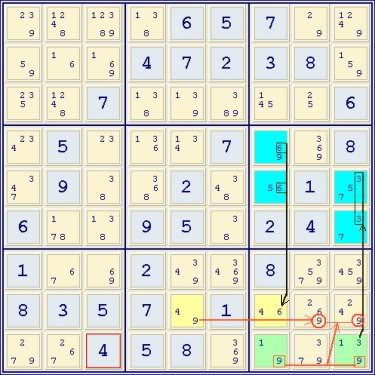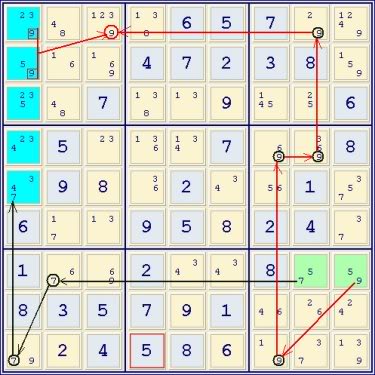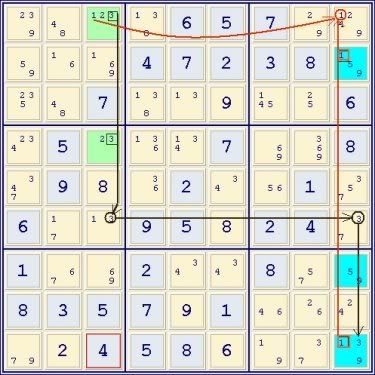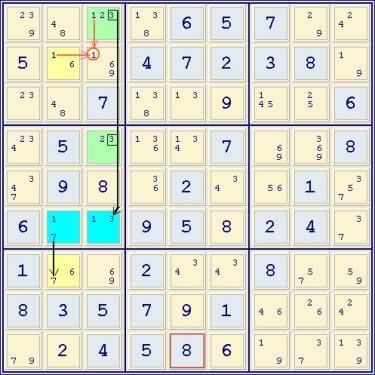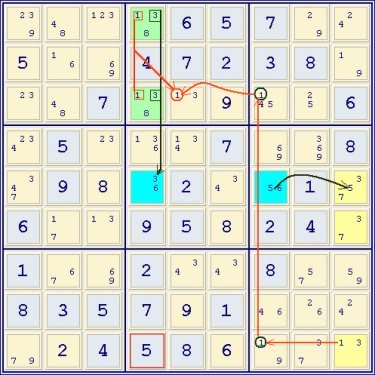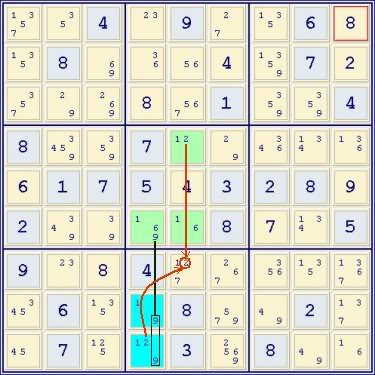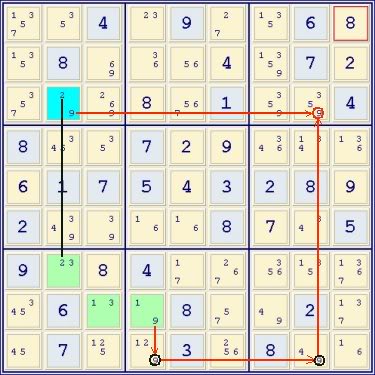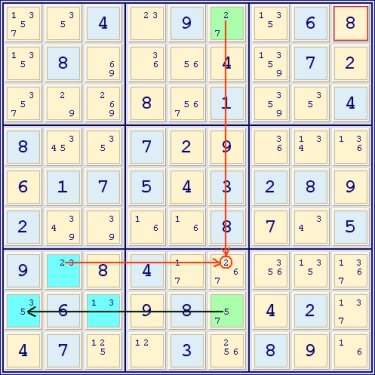INTRODUCTION
A previous tutorial described the use of Basic ALS Chains. If you are relatively unfamiliar with ALS Chains then you should start with the Basic ALS Chains tutorial here:
viewtopic.php?t=6443&start=0
The distinction between basic and advanced ALS Chains is somewhat arbitrary and there will be some overlap between the two. However, broadly, the differences are very real. The possibility of manually-derived advanced ALS Chains was suggested to me by the relatively complex computer-derived ALS Chains used to solve an advanced puzzle recently on this forum (see Credits). Those results indicated that ALS Chains are more prevalent and can be used to solve more difficult puzzles than previously thought. However, particularly exciting to me is that fact that the examples presented here confirm that advanced ALS chains can also be found manually and provide yet another method of solving advanced-difficulty puzzles.
WHY ADVANCED ALS CHAINS?
As mentioned in the previous tutorial, finding ALS Chains, especially when using a Sudoku solver (purely as a frontend) such as Simple Sudoku that allows the manual coloring of cells, is pure pattern solving (or pattern A solving as I call it to distinguish it from finding chain-based patterns or pattern B solving). The benefit of utilizing these patterns is two-fold: First, one doesn’t have to know a lot about the underlying logic to use them and so they can serve as a very powerful ‘next step’ after basic solving methods that likewise use pattern A solving (x-wings, 2-string kites and the like), but without having to know anything about nice loops or AIC chains. Basic ALS Chains can provide end-stage solving solutions of the most difficult newspaper puzzles and perhaps of puzzles a little beyond that level, but Advanced ALS Chains are far more powerful and can solve a number of Extreme level puzzles that previously required chains such as nice loops and AICs to solve. Second, if one is experienced in solving with nice loops and AICS and, in addition, develops proficiency in finding the advanced ALS patterns described below, they will provide new sources of strong links for use in chains even if one has no interest in solving puzzles with pure ALS Chain patterns.
But there’s actually a third reason to solve with advanced ALS chains: it’s fun! Think of trying to solve Extreme level puzzles with nothing but ALS chains as a new form of challenge: a puzzle within a puzzle! This may be just what you need if you’re getting tired of the same old same old!
Here's a good example of the sort of fun I get out of the pure pattern solving of ALS Chains (basic or advanced) and a reason why I think they add a new realm of sudoku solving enjoyment. Below is a graphic of the latest version of the Iphone/Itouch app, Enjoy Sudoku, showing the same pattern as the first graphic in the examples that follow (note that the pink cells are where the eliminations take place). The author very kindly added the ability to color cells after a strong
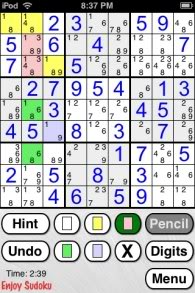
DIFFERENCES BETWEEN BASIC AND ADVANCED ALS CHAINS
The differences between basic and advanced ALS chains range from subtle to obvious. Basic ALS chains tend to consist more of 2 or 3 cell sets. Bivalue cells are common. The cells of the sets are more often than not inline ie. tend to follow each other in a row or column. The general patterns of basic ALS chains are relatively easy to see and easy to find. Finding advanced ALS chain patterns is not as intuitive a process, particularly when one is looking for them for the first time. But with practice it turns out that they are really only hiding in plain sight. They are also surprisingly common even in Extreme level puzzles and even where there are fewer bivalue cells.
Some of the constructs of advanced ALS chain patterns that distinguish them from basic ALS chains are:
a) Sets can contain as many as 5-6 (or even more) cells.
b) Cells of a set may be arranged in particularly irregular patterns.
c) The cells of a set may be some distance from each other.
d) A cell or cells of one set may be surrounded by the cells of another set.
e) 2 sets may share a common cell.
f) More than one conjugate-based link may be used.
Manually-derived examples of of these patterns follow directly below and are from the UK forum Extreme #133 which was largely solved using advanced ALS chains. Following those are the complete solutions of 2 Extreme-level puzzles using nothing but advanced ALS chains (and basic methods as necessary). An attempt has been made to keep the graphics as simple as possible for maximum clarity. The restricted commons are connected with black lines and red lines are used to join the digits in flanking sets with the digit(s) for elimination which are circled in red. Digits that are part of conjugate pair links are circled in black. Conjugate strong links are described using the #-conjugate terminology where # is the digit value being used eg. 1-conjugate for a pair of 1s in a row or column.
UK forum Extreme #133
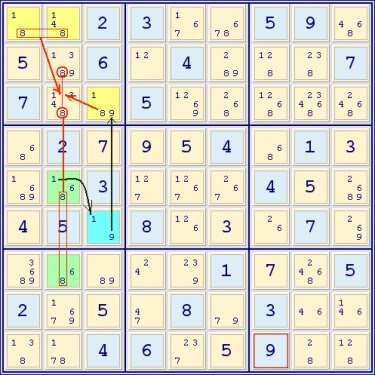
Green set-> rc=1 ->Blue set-> rc=9 ->Yellow set => r23c2<>8
A 3-set chain with a bivalue cell as a middle set (this pattern sometimes referred to as a Death Blossom).
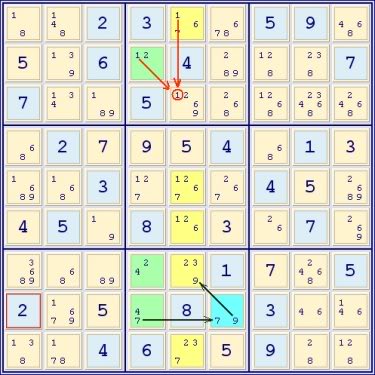
Green set-> rc=7 ->Blue set-> rc=9 ->Yellow set => r3c5<>1
A fairly complex pattern (generally, a Death Blossom pattern similiar to the previous chain) with a 5-cell Yellow set.
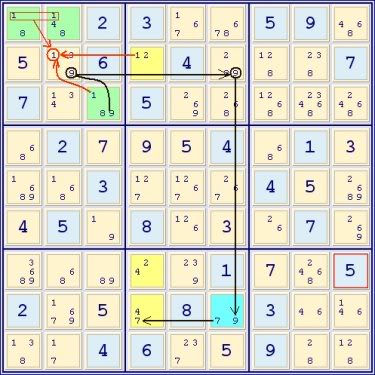
Green set-> rc=9 thru 9-conjugate ->Blue set-> rc=7 ->Yellow set => r2c2<>1
Another 3 set chain with a middle bivalue cell (aka Death Blossom) and there is one conjugate-based link.
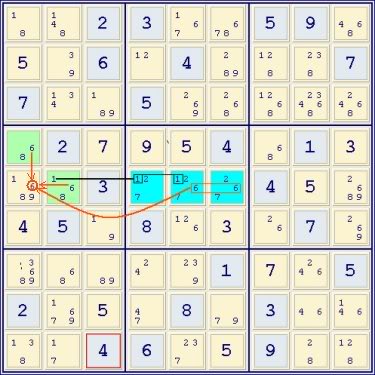
Green set-> rc=1 ->Blue set => r5c1<>6
Not too complex a pattern, but not all that obvious either.
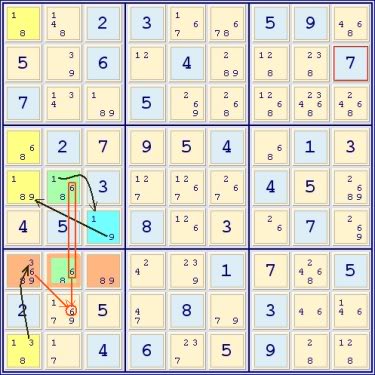
Green set-> rc=9 ->Blue set-> rc=3 ->Yellow set =>r8c2<>6
A particularly complex 4 set chain and one of the more difficult to find manually. A common ‘overlay’ cell, r7c2, used in both the Green set and the Brown set, is required to make it work. Thus the Green set is r57c2 and the Brown set is r7c123.
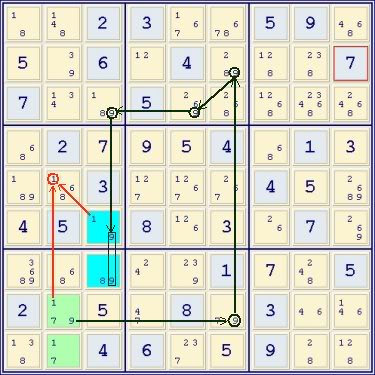
Green set-> rc=9 thru dual 9-conjugate ->Blue set => r5c2<>1
The 2 sets are simple, but the restricted common connection between them, a dual conjugate-based link is not. At first glance, it would not seem obvious that the 2 sets, though close to each other, could be connected.

Green set-> rc=1 ->Blue set => r3c7<>6
Another pattern that would be hard to find if one wasn’t thinking outside the box
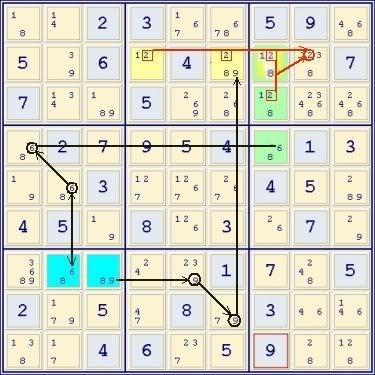
Green set-> rc=6 thru 6-conjugate ->Blue set rc=9 thru 9-conjugate => r2c8<>2
An extremely complex pattern utilizing 2 conjugate-based links and a common overlay cell. Both the Green and Yellow sets require r2c7 to be valid and make the pattern work. Thus, the Green set is r234c7 and the Yellow set is r2c467.
The solutions to 2 Extreme level puzzles follow below both to reinforce how powerful advanced ALS chains are and to give several examples of many of the various general patterns that are possible. The basic methods such as locked candidates, x-wings and the like that were used as they became available during the solving process are not shown. Also no attempt was made to optimize the solutions. Not necessarily all the ALS chains shown are mandatory for the final solution.
A note about the Extreme level puzzles and the ER difficulty rating: The ER rating for these puzzles is often deceivingly low and may sometimes not appear to be that much higher than the newspaper Diabolicals ie. 7.1 to 7.3. But the fact is that while most newspaper Diabolicals can be mostly or totally solved with basic methods, the Extremes almost always require advanced methods such as nice loops or AIC chains to solve.
(Credits: Paul Isaacson’s excellent recent work on computer-derived ALS Chains inspired some of the above search for manually-derived advanced ALS chains.)


